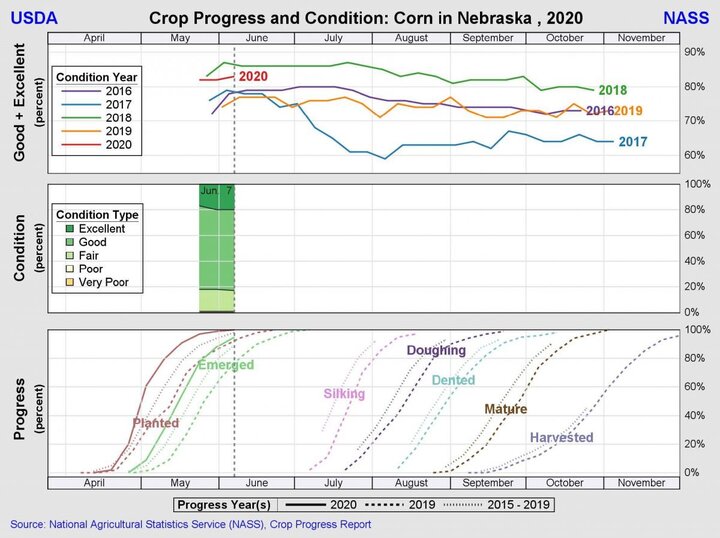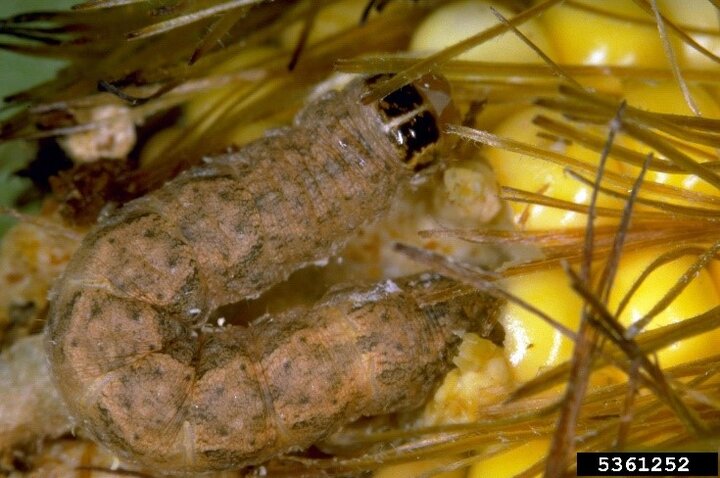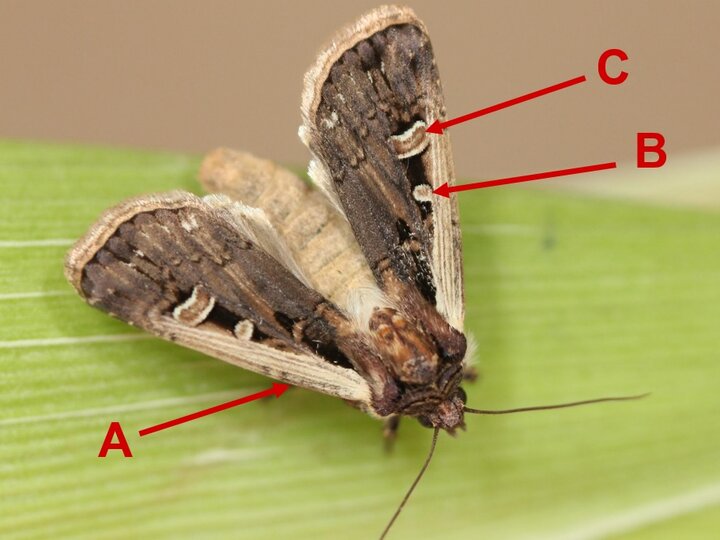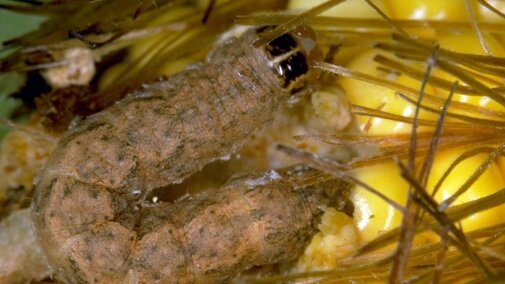Degree-Day Model Introduction
It is important for producers and crop consultants to know when the damaging life stage of an insect pest will be present in the field. This knowledge allows for more efficient scouting and management decisions. However, this time can be difficult to predict based upon the calendar date alone, as insect development is influenced by variable weather conditions such as temperature.
Degree-day models provide a more accurate prediction. Degree-days measure the amount of heat an insect has been exposed to between a lower and upper threshold. Through field and laboratory studies, entomologists have been able to develop degree-day models for several species of insects.
Every degree-day model will differ, but a typical way of measuring degree-days is to subtract the lower threshold from the average temperature for each day. For example, if a certain day had a low of 50°F and a high of 70°F and our model had a lower threshold of 38°F and upper threshold of 75°F then the degree-days would be:
[(70 + 50)/2]-38
[120/2] – 38 = 22 degree-days
Note: If the average temperature is lower than the lower threshold (38°F) then change the average temperature to the lower threshold prior to subtracting the lower threshold. If the average temperature is higher than the upper threshold (75°F) then change the average temperature to the upper threshold prior to subtracting the lower threshold.
Predicting WBC Flight
A degree-day model for western bean cutworm flight was published in 2014 by Entomologists at the University of Nebraska-Lincoln (Robert Wright and Tom Hunt) and University of Minnesota (Roger Moon, Bill Hutchinson, and Anthony Hanson). Their paper showed that the best method for predicting the time of WBC flight uses simple degree-day calculations starting on the 1st of March. A lower threshold of 38°F and an upper threshold of 75° is used. Under this model 25% of WBC flight occurs when 2,577 degree-days Fahrenheit have been accumulated. It is at this time that field scouting should begin (Table 1).
| % Flight | Degree-Days (F) |
|---|---|
| 5 | 2,377 |
| 10 | 2,456 |
| 25 | 2,577 |
| 50 | 2,704 |
| 75 | 2,838 |
| 90 | 2,977 |
| 95 | 3,077 |
Predicted Dates for 2020 Western Bean Cutworm Flights in Nebraska and Adjacent States
Both the predicted dates for WBC emergence (Table 2) and corn development (Figure 1) are earlier than 2019. The growth stage of the corn during WBC flight is critical as moths prefer to lay their eggs on corn plants between the late whorl to early tassel stage. Survival of young WBC larvae is highest if they can feed on newly emerged tassel prior to moving into the ears.
Temperatures are taken from the High Plains Regional Climate Center (HPRCC) for March 1 to June 11. For dates after June 11 the eight year (2012-2019) average was used. Note that some error may occur since these temperatures are predicted rather than actual. Higher than average temperatures will result in earlier WBC flight and lower than average temperatures will result in later WBC flight. For example, last year we predicted that 25% emergence at North Platte would occur on the July 23, but it actually occurred on July 25. Up to date degree accumulation for your area may be found on the University of Nebraska’s Mesonet website (select "Bean Cutworm Moth Growing Degree Days" form the drop down menu).
UNL’s free AgriTools mobile app has added a new feature for 2020 that automatically calculates degree-days for your location and shows you how this impacts pest development for the western bean cutworm, seed corn maggot, and common stalk borer!
| Location | Coordinates | Elevation | 5% | 10% | 25% | 50% | 75% | 90% | 95% |
|---|---|---|---|---|---|---|---|---|---|
| Ainsworth, NE | 42.57 -99.83 | 2500 | 13-Jul | 15-Jul | 18-Jul | 22-Jul | 25-Jul | 29-Jul | 1-Aug |
| Alda, NE | 40.88 -98.52 | 1923 | 6-Jul | 8-Jul | 12-Jul | 15-Jul | 19-Jul | 23-Jul | 25-Jul |
| Axtell, NE | 40.52 -99.05 | 2198 | 6-Jul | 8-Jul | 11-Jul | 15-Jul | 19-Jul | 22-Jul | 25-Jul |
| Big Springs, NE | 41.15 -102.00 | 3701 | 11-Jul | 13-Jul | 17-Jul | 20-Jul | 24-Jul | 28-Jul | 31-Jul |
| Brule, NE | 41.02 -101.97 | 3474 | 9-Jul | 11-Jul | 15-Jul | 18-Jul | 22-Jul | 26-Jul | 29-Jul |
| Champion, NE | 40.40 -101.73 | 3517 | 10-Jul | 12-Jul | 15-Jul | 19-Jul | 23-Jul | 26-Jul | 29-Jul |
| Concord, NE | 42.38 -96.9 | 1545 | 10-Jul | 12-Jul | 16-Jul | 19-Jul | 23-Jul | 27-Jul | 30-Jul |
| Cozad, NE | 40.97 -99.95 | 2562 | 12-Jul | 14-Jul | 18-Jul | 21-Jul | 25-Jul | 29-Jul | 1-Aug |
| Douglass, WY | 42.80 -105.45 | 4892 | 26-Jul | 28-Jul | 1-Aug | 5-Aug | 9-Aug | 14-Aug | 17-Aug |
| Duncan, NE | 41.40 -97.53 | 1562 | 5-Jul | 8-Jul | 11-Jul | 14-Jul | 18-Jul | 22-Jul | 24-Jul |
| Elgin, NE | 41.93 -98.20 | 2064 | 10-Jul | 12-Jul | 15-Jul | 19-Jul | 22-Jul | 26-Jul | 29-Jul |
| Fordyce, NE | 42.75 -97.35 | 1460 | 9-Jul | 11-Jul | 14-Jul | 18-Jul | 21-Jul | 25-Jul | 28-Jul |
| Harvard, NE | 40.57 -98.15 | 1824 | 6-Jul | 8-Jul | 11-Jul | 14-Jul | 18-Jul | 22-Jul | 25-Jul |
| Holyoke, CO | 40.48 -102.10 | 3694 | 11-Jul | 13-Jul | 16-Jul | 20-Jul | 24-Jul | 28-Jul | 31-Jul |
| Ithaca, NE | 41.15 -96.50 | 1161 | 4-Jul | 6-Jul | 9-Jul | 13-Jul | 16-Jul | 20-Jul | 23-Jul |
| Kearney, NE | 40.72 -99.02 | 2129 | 6-Jul | 8-Jul | 12-Jul | 15-Jul | 19-Jul | 22-Jul | 25-Jul |
| Lincoln, NE | 40.75 -96.68 | 1250 | 29-Jun | 1-Jul | 5-Jul | 8-Jul | 12-Jul | 15-Jul | 18-Jul |
| Memphis, NE | 41.15 -96.45 | 1152 | 4-Jul | 6-Jul | 9-Jul | 12-Jul | 16-Jul | 20-Jul | 23-Jul |
| Merna, NE | 41.45 -99.78 | 2641 | 13-Jul | 15-Jul | 18-Jul | 22-Jul | 25-Jul | 30-Jul | 2-Aug |
| Mitchell, NE | 41.95 -103.70 | 4114 | 13-Jul | 15-Jul | 18-Jul | 22-Jul | 25-Jul | 30-Jul | 1-Aug |
| Nebraska City, NE | 40.70 -95.90 | 1079 | 30-Jun | 2-Jul | 6-Jul | 9-Jul | 13-Jul | 16-Jul | 19-Jul |
| North Platte, NE | 41.08 -100.78 | 2841 | 10-Jul | 12-Jul | 15-Jul | 19-Jul | 22-Jul | 26-Jul | 29-Jul |
| Oakland, NE | 41.83 -96.55 | 1348 | 11-Jul | 13-Jul | 16-Jul | 20-Jul | 23-Jul | 27-Jul | 30-Jul |
| Scottsbluff, NE | 41.88 -103.68 | 3934 | 13-Jul | 15-Jul | 18-Jul | 22-Jul | 25-Jul | 30-Jul | 1-Aug |
| York, NE | 87 -97.63 | 1637 | 4-Jul | 6-Jul | 10-Jul | 13-Jul | 17-Jul | 20-Jul | 23-Jul |

Western Bean Cutworm Scouting and Integrated Pest Management
The western bean cutworm can be a significant pest of corn and dry bean, especially in areas with sandy soils. Western bean cutworm egg masses are usually found on the upperside of corn leaves and the underside of dry bean leaves. There are typically about 50 eggs per mass although there may be as few as 5 or as many as 200. The eggs are spherical with ridges. They are white when freshly laid but gradually turn darker with age (Fig. 2). After hatching the larvae will consume their eggshells. Older larvae are recognizable by two black rectangular markings behind their head (Fig. 3). Adult moths have a length of approximately 0.7 inches and a wing span of 1.5 inches. They are most easily distinguished from other moths by the presence of a white band on the front of the forewing. Just behind this is a white dot and a white crescent located 1/2 and 2/3 of the way down the length of the wing respectively (Fig. 4). For a detailed description of this pest refer to the Nebraska Extension NebGuide, Western Bean Cutworm in Corn and Dry Beans.



Also consider:
- Using Nebraska Extension’s free Western Bean Cutworm Speed Scout App or Spreadsheet
- For corn without effective Bt traits against WBC the recommended treatment threshold is 5-8% of corn plants with eggs or larvae
- Transgenic Bt corn with Cry1F (Herculex) proteins may provide some WBC feeding suppression; however, their efficacy has lessened in recent years and should not be relied upon as a stand-alone control for WBC. Corn with VIP3A proteins are still effective (see Nebraska perspective on efficacy of Cry1F Bt corn against western Bean Cutworm)
- See the Handy Bt Trait Table for a list of Bt trait packages that are still effective against WBC.
- Management decisions in dry bean are most easily made by using pheromone traps. See the NebGuide cited above for more information. These pheromone traps should be setup in late June to early July well before 5% predicted fight.
- Other resources include UNL black light trap reports from North Platte, Clay Center, Concord, and Mead.

